
When it comes to getting the most out of your marketing dollars, sometimes a little help is required. But there’s good news for contractors and business owners in the home performance, HVAC and solar industries: big name brands – like Mitsubishi, Trane, or Panasonic, to name a few – want to help get the word out about their products. Co-op marketing dollars not only lighten the financial burden of marketing at the contractor level, but they also offer a unique opportunity to utilize big-box brand recognition for your business, as Energy Circle CEO Peter Troast discussed in detail during last week's webinar.
Not every cooperative marketing program is created equal (as we have found out), but that doesn't mean you should be leaving that cash on the table! Here is what you should know about co-op marketing, and how you can use these programs to maximize the effectiveness of your own marketing efforts.
How Marketing Co-ops Work
Cooperative (or “co-op”) marketing is a way that manufacturers, distributors, suppliers, and programs can support HVAC, solar, and home performance contractors by aligning their marketing resources. This is usually done through funding for specific ad campaigns or through matching co-op dollars. Manufacturers who are attempting to build loyalty to their products and their brand are constantly on the hunt for value-added programs that they can provide to contractors to gain your loyalty, and your preference to their products. At the same time, these entities are trying to maximize their brand reach. These co-op programs come in a variety of “flavors”:
Manufacturer Matching Fund Program for Specific Marketing Tactics
This co-op type matches any marketing dollars spent on qualifying marketing tactics. Matching percentage can range from 30% to 50%, and in some cases (mostly the HVAC world) the total marketing spend can be split three ways — the manufacturer, the distributor, and the contractor. But some programs will separate which marketing tactics will qualify, so make sure to read the program specifications!
Dealer Incentive Programs with Marketing as Eligible Expense
These co-op programs are often based on a qualifying purchase, like your overall purchasing volume from that particular dealer. This can come in the form of “points” similar to a loyalty program, or we have seen this type of program accrue in dollars too. Owens Corning runs a co-op like this — and one benefit to this kind of program is that you can then put those dollars towards whatever you want (eg: new equipment, branded uniforms, etc).
Efficiency Program Matching Funds
Some efficiency programs (like New Jersey Clean Energy program) offer matching funds to get the word out on state run incentives. Ad messaging for incentive programs usually revolves around aftermarket rebates, and using an “authorized” or “approved” contractor.
Dealer Network Benefit Packages
This co-op program does as much of the work for you as possible, by providing pre-made, and oftentimes customizable marketing assets for you to use for a discounted rate. This relieves the burden of creating your own marketing materials from scratch.
Typical Co-op Eligibility
Qualifying for these programs will involve reading the fine print. Qualifications vary, depending on the individual program. But most will provide comprehensive and straightforward outlines for what marketing strategies will be approved for co-op funding. Most programs even go as far back in the advertising time machine as approving yellow page ads! So you will likely be able to find value in most co-op programs relevant to your business.
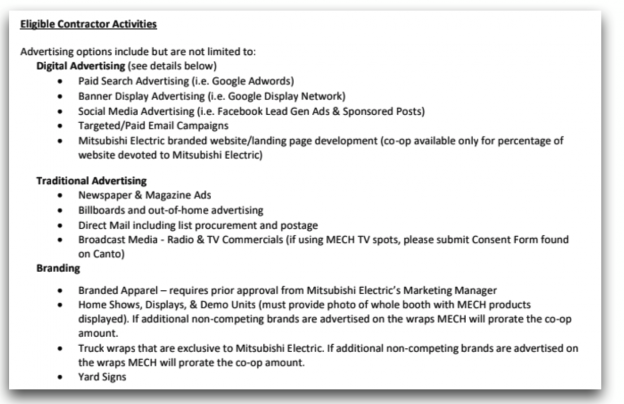
Guidelines and Requirements
Because co-ops offer the unique opportunity to utilize the creative assets of a much larger company, there can be restrictive guidelines for how your promotional materials and marketing assets look, and the content they are required to have. In this example, the copy that is required for any ad involving the New Jersey Clean Energy Project includes copy requirements of nearly 400 characters — which zooms past the Google Ads character limit of 90 characters.
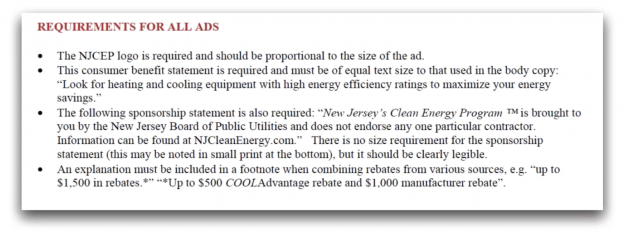
Advantages to Co-op Marketing
So why would you bother jumping through these brand guideline hoops and marketing requirements? Because there is money in it! Not only are you able to use someone else’s money in your marketing efforts, it allows you to stretch your current marketing budget. This frees your marketing budget up for some experimenting — like allocating more cash into your PPC ad spend, or utilizing other marketing tactics that traditionally don't offer a 100% ROI (like print, billboards etc). And like we’ve already mentioned, you get the benefit of pairing your own brand with a larger, well-known brand. This can elevate your brand locally, and drive the point home that you are the trusted and authorized contractor of a well known manufacturer’s products.
How Marketing Co-ops Look
With the scare of all of those branding guidelines and requirements, you may be wondering what a co-op ad can look like once the “i’s” are dotted and the “t’s” are crossed:
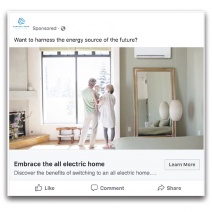
For some co-ops, your hands aren’t tied to including other brands and logos in all of your marketing efforts related to that co-op. This particular facebook ad contains nothing about any particular manufacturer or brand other than the contractor, until of course the link is clicked to “learn more”. This is where the Mitsubishi Electric approved copy lives.
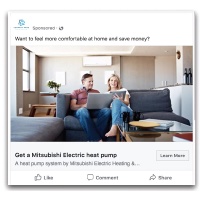
This facebook ad is the next level up — Mitsubishi is utilized in the link copy, but is still underscored by your locally recognized brand.
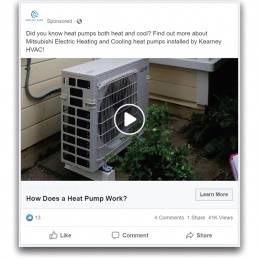
n this case, we flip the script with Mitsubishi only mentioned in the post copy, not in the link. Some co-ops can provide plenty of flexibility in how you handle your marketing assets.
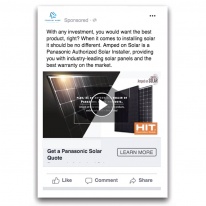
This solar ad campaign takes advantage of the Panasonic HIT Solar Panel co-op marketing program. This is a prime example of using the imagery and recognition of a larger company across your digital marketing channels.
Best Practices & Overcoming Challenges
It’s unlikely you escaped your childhood without hearing the phrase “there ain’t no such thing as a free lunch!” or “money doesn’t grow on trees!” Marketing co-ops can provide a valuable boost for your marketing efforts, but you may have to jump through a few hoops. Here are some actionable tips to making your marketing co-op experience as painless as possible:
Read the fine print, and embrace the system. Once you can get your co-op assets in place, it will be that much easier to utilize next year!
Be aware of any inconsistent approval processes, and that it may take time to get your ads approved!
Let someone else do it! As a full-service digital marketing firm, we have been in the trenches of sorting out the details of the available marketing co-ops — we know how to avoid the pitfalls.
Cash flow - know what you are getting into. You will probably have to front 100% of the cost, and it can take upwards of 6 months for reimbursement. Basically, don’t wait until December!
These larger brands are putting their money where their mouths are. So why not take advantage? Collaborating with a well known company like Mitsubishi, Panasonic, or Owens Corning fosters trust — and co-ops truly are a win-win situation as long as you are willing to read the fine print.